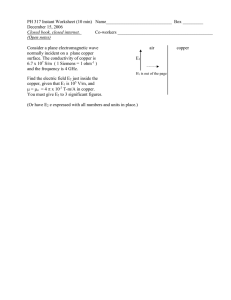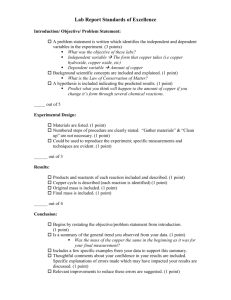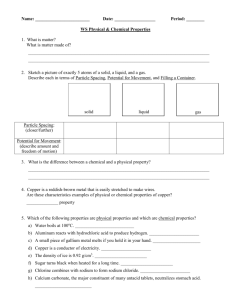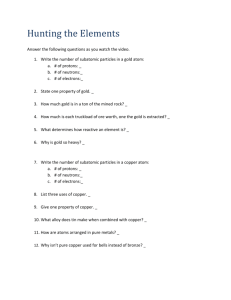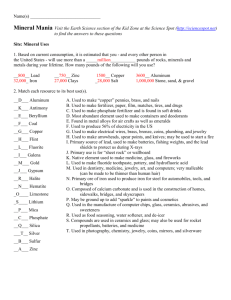The Importance of Minerals and Mining
advertisement
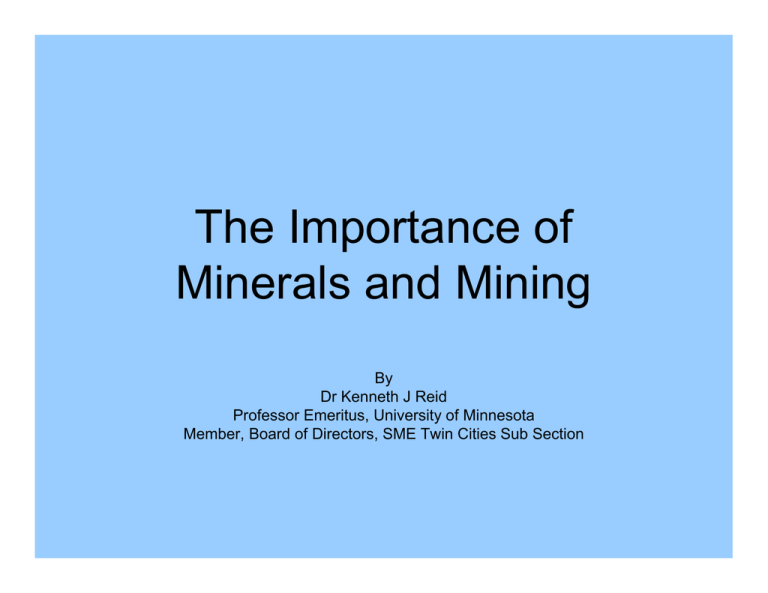
The Importance of Minerals and Mining By Dr Kenneth J Reid Professor Emeritus, University of Minnesota Member, Board of Directors, SME Twin Cities Sub Section Let’s start on a Monday morning. Six o’clock Monday morning. Ti Time to t gett up. Electricity to run the clock comes through Copper Wires. Copper comes from a Copper Mine. Copper pp Sulfide minerals have to be concentrated to separate them from worthless Minerals. The ore is hauled In large Haul Trucks. Some are 24ft high g and 30ft wide with tires 14 ft tall!!! The copper ore is crushed and then ground t a fine to fi powder d in i Ball B ll Mills. Mill The fine ore goes to banks of Flotation Cells i the in th Copper C C Concentrator, t t and the Copper Sulfide Minerals are collected ll t d on bubbles. b bbl The Concentrate is dried and the Sulfur i burned is b d off ff in i a furnace. f Molten copper is cast into Anodes which hi h are refined fi d to t make k Copper C Rods. R d The Copper Rods are heated and extruded t make to k C Copper C Coils, il and wire is made from the Copper pp Coils. It takes a lot of work to get from the Minerals in the rocks in the Copper Mine to the Copper wire bringing electricity to the clock. The electricity comes through power lines, from a Coal fired Power Plant made out of Concrete and Steel. O Over 50% off all ll electricity l t i it used d in i USA comes from Coal Fired Power Plants. The Coal might come from a distant O Open Pit Coal C l Mine, Mi delivered by y long g Unit Trains. The Coal is burnt in boilers to generate steam which drives the g generators to make electricity. y Power distribution requires a lot of Structural Steel, which comes in many different shapes h and d sizes. i To make Steel we need Iron Ore. H Here it comes ffrom a Minnesota Mi t Taconite T it Mine. Mi The ore goes to a Taconite Pellet Plant, and a d is s made ade into to Taconite aco te Pellets e ets, which are delivered by train to L k Superior Lake S i docks, d k and transported by ship to L Lower Lakes L k Steel St l Mill Mills, where they y are fed into a Blast Furnace With Coke (made from coal) and Limestone to make liquid iron. Molten iron is tapped from the Bl t Furnace, Blast F and poured into a Basic Oxygen Furnace to make Steel. Large steel sections are made from ingots i large in l I t Integrated t d Steel St l Mills, Mill while small shapes like rebar are often made d from f S Scrap I Iron i Mini in Mi i Mills. Mill What about Concrete? All roads d and db buildings ildi need d Concrete. C t Concrete is made with Sand from Sand Pits,, and Crushed Rock Aggregates, gg g , from a Rock Quarry, Q y, and Cement. Cement is made at a Cement Plant in a hi h temperature high t t C Cement t Kil Kiln, from o Limestone esto e and a d other ot e minerals, e a s, with the Limestone mined in a Li Limestone t Quarry. Q It’s 6:05. Ti Time to t gett up and d go to t the th bathroom. b th We use the toilet, clean our teeth and d take t k a shower. h Where does the water come from? It comes into the house through g Copper Pipes, after purification in the local W t Treatment Water T t t Plant, Pl t which receives large volumes of water th through h Steel St l Pipes, Pi or large g Concrete Conduits,, from a River or a R Reservoir i behind b hi d a Concrete C t Dam. D Where does the toilet come from? Th toilet The t il t is i a Ceramic C i product, d t and all Ceramic p products are made from Clay, y, mined from a Clay y Pit. When we flush,, the waste water leaves the house in Cast Iron Pipes, and g goes through g large Concrete Sewer Pipes, to a Waste Water Treatment Plant,, and now it’s 6:15. Ti Time for f breakfast. b kf t Our food is stored in Refrigerators made with Steel, Copper, Aluminum, Plastics and Paints. But before breakfast be sure to get your Vitamins and Minerals. They’re essential for good health. Let’s have a donut. Fi ll something Finally thi that’s th t’ nott mineral. i l But the donut comes from the bakery, y, and the bakery y needs Flour,, which comes from a Flour Mill constructed t t d with ith concrete t and d steel. t l The grain is transported b train by t i on steel t l rails, il and is harvested by large C Combine bi Harvesters. H t All plants need mineral Fertilizers. Nitrogen g ((N)) is p provided by y Liquid q Ammonia,, Urea or Ammonium Salts. Phosphorus (P) comes from a Ph Phosphate h t Mi Mine, and Potassium ((K)) from a Potash Mine,, where the Underground Mine tunnels can extend t d for f many miles. il Agricultural machinery is needed t till the to th ground. d Without modern machinery we go back b k to t Horse H P Power, and without Minerals: no donuts, no television, no cities, iti no modern d civilization i ili ti . That’s the first half hour of the week and look at all ll the th Mines Mi and d Minerals Mi l we’ve ’ had h d to t rely l on. So: Are Minerals Important? Y B You Betcha h Absolutely everything we depend on is either made from minerals or relies on minerals for its production. RED WORD LIST COPPER COPPER MINE COPPER SULFIDE MINERALS HAUL TRUCKS BALL MILLS FLOTATION CELLS CONCENTRATOR CONCENTRATE SULFUR ANODES POWER PLANT COAL OPEN PIT UNIT TRAINS STRUCTURAL STEEL IRON ORE TACONITE PELLET PLANT TACONITE PELLETS STEEL MILLS BLAST FURNACE COKE LIMESTONE BASIC OXYGEN FURNACE INTEGRATED STEEL MILLS SCRAP IRON MINI MILLS CONCRETE SAND SAND PITS AGGREGATES ROCK QUARRY CEMENT CEMENT PLANT CEMENT KILN LIMESTONE QUARRY COPPER PIPES WATER TREATMENT PLANT STEEL PIPES CONCRETE CONDUITS RESERVOIR DAM CERAMIC CLAY CLAY PIT CAST IRON SEWER PIPES WASTE WATER TREATMENT PLANT VITAMINS AND MINERALS FLOUR FLOUR MILLS COMBINE HARVESTERS FERTILIZERS NITROGEN LIQUID AMMONIA UREA AMMONIUM SALTS PHOSPHORUS PHOSPHATE MINE POTASSIUM POTASH UNDERGROUND MINE HORSE POWER For more information about minerals and their uses, visit: The Mineral Information Institute at www.mii.org
